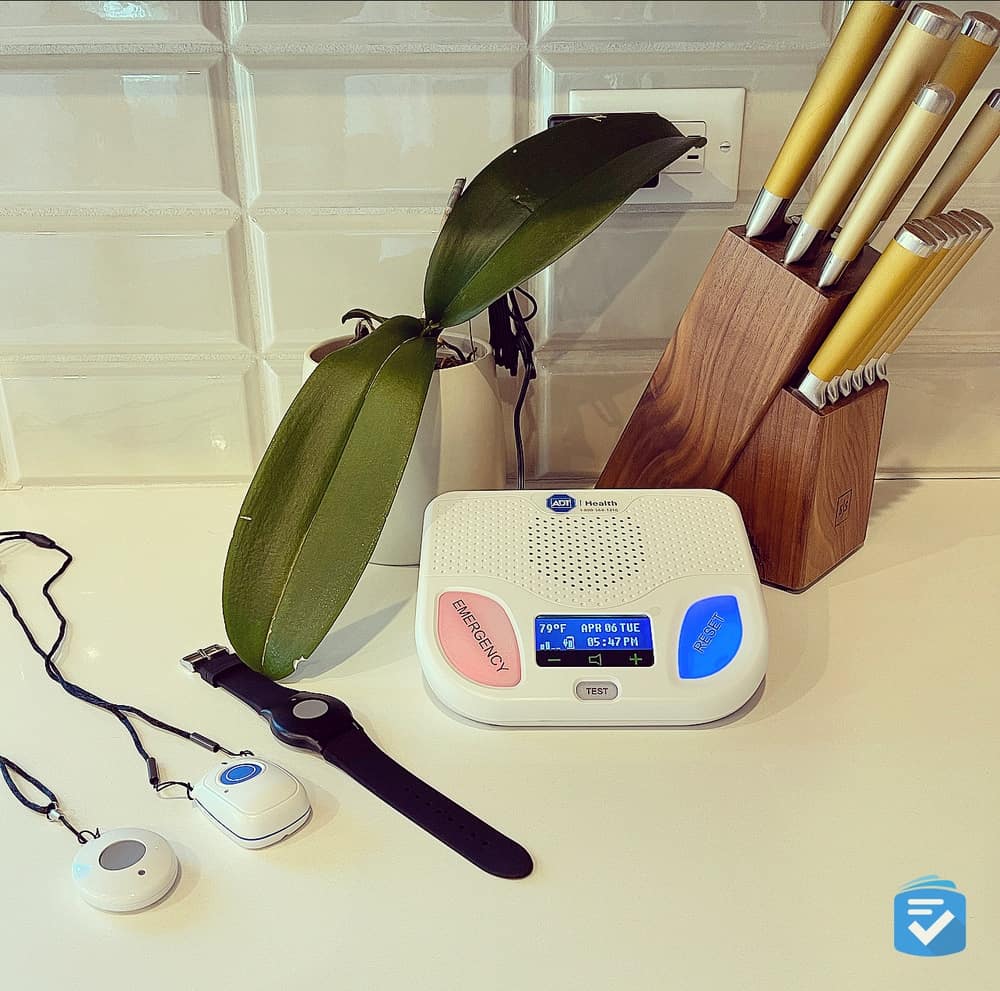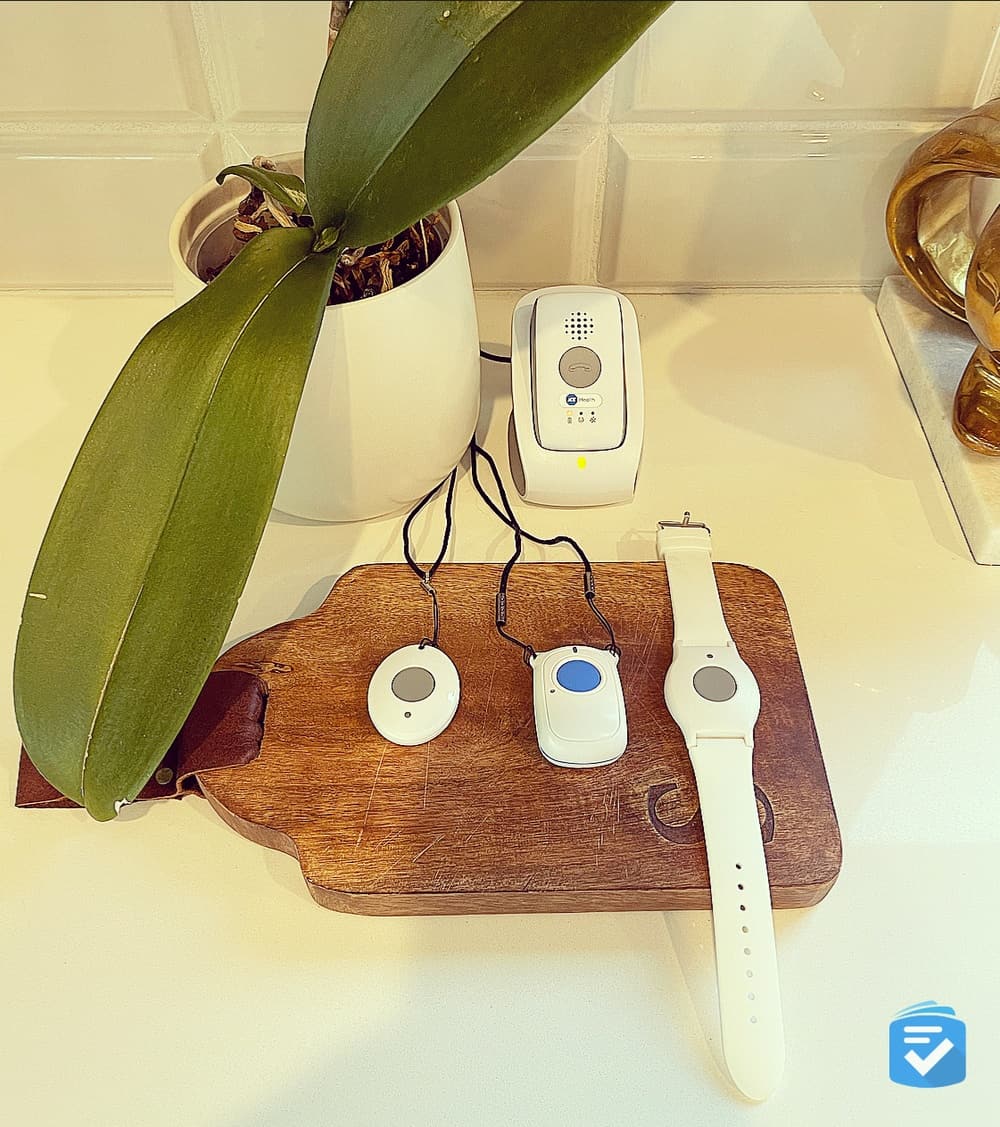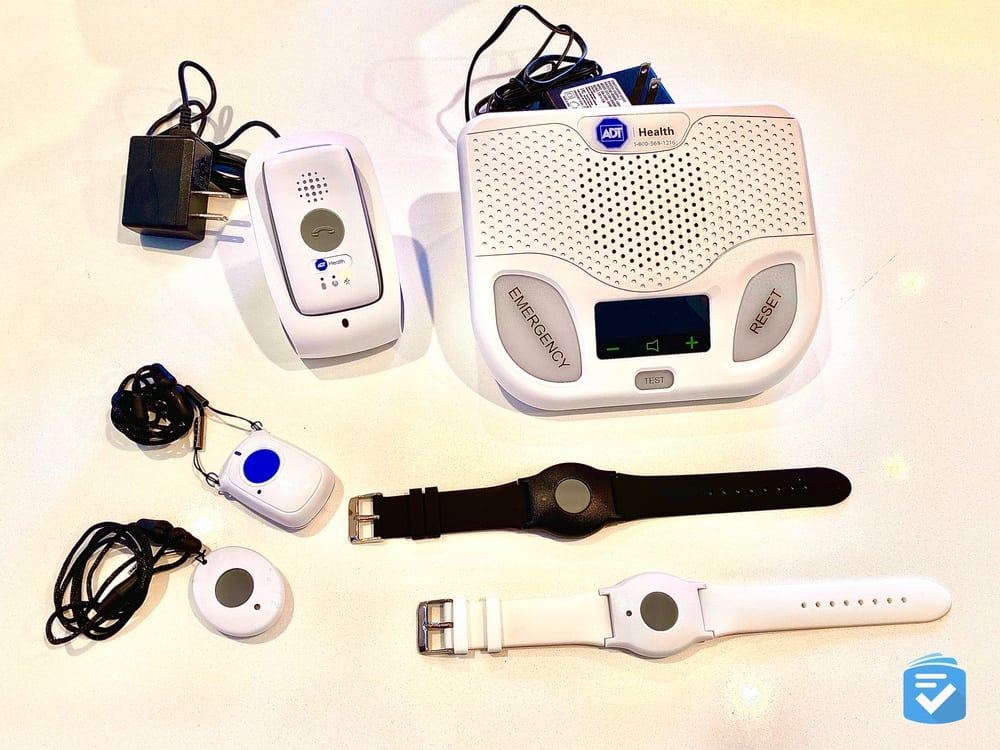
ADT Medical Alert Review, Hands-On Test

Looking for reliable protection for yourself or a loved one? Our in-depth testing of ADT’s medical alert systems revealed impressive emergency response times, averaging just 14 seconds – among the fastest we’ve tested.
While ADT’s pricing starts at $31.99 monthly (slightly higher than competitors), their systems delivered consistent performance with waterproof help buttons, temperature monitoring, and optional fall detection that accurately detected emergencies. Despite lacking caregiver app functionality and having limited in-home range, ADT’s price-lock guarantee and dependable service make these systems worth considering.
ADT Medical Alert: Key Findings
- ADT medical alert systems connected us to help in an average of 14 seconds, making them one of the fastest companies we’ve tested.
- ADT’s systems start at $31.99 for an in-home system and $41.99 for a mobile system.
- The company has yet to introduce any type of app or portal for caregivers.
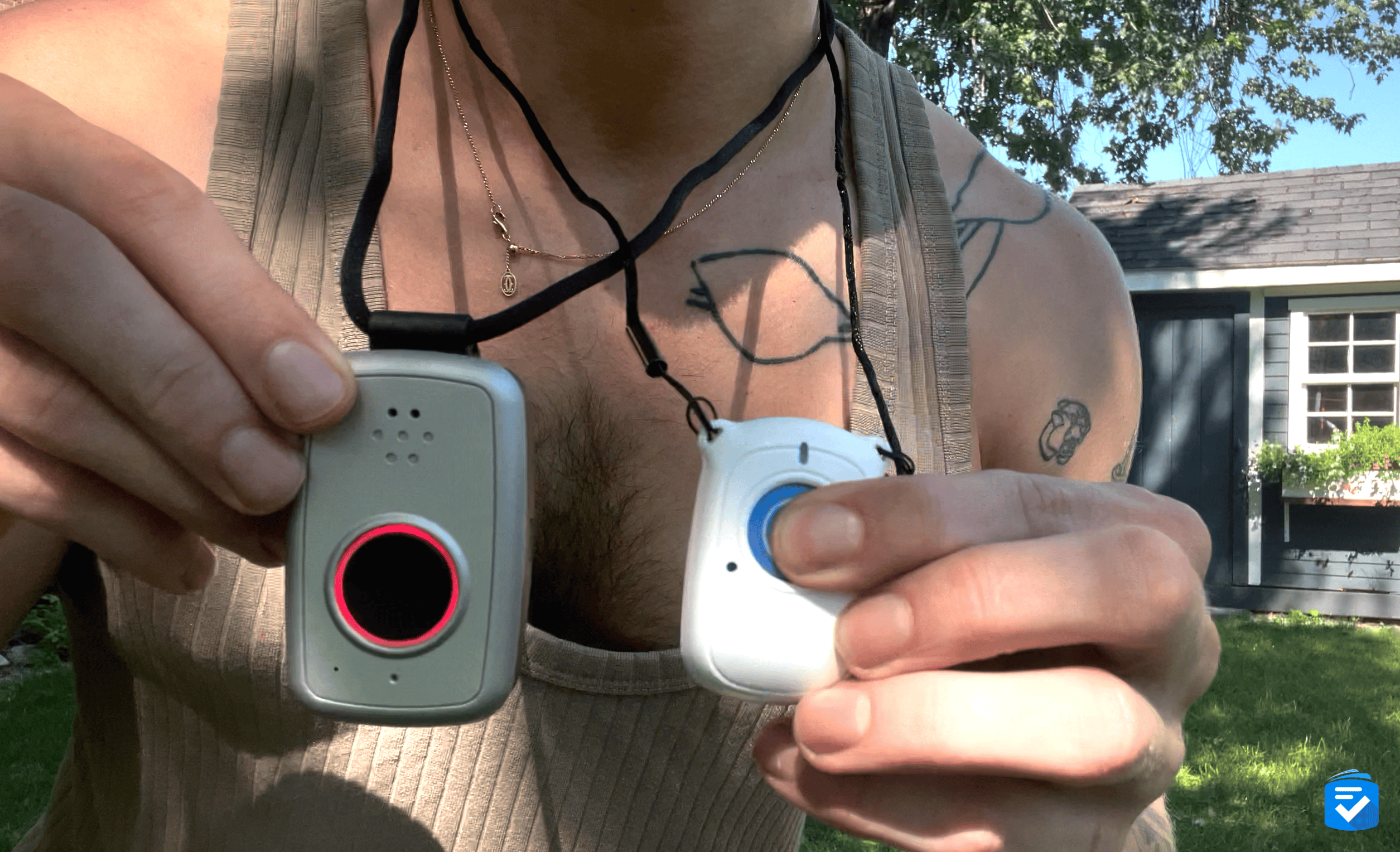

Why Trust TheSeniorList?
Our team of caregivers, experts, and healthcare professionals conducted over 5,000 hours of in-depth research and testing. The results helped us recommend the most reliable brands and devices. In this process, our team:
- Tested 50 medical alert devices from 15 different brands.
- Surveyed 1,250 seniors and caregivers on medical alert system usage.
- Consulted with nurses, EMTs, and caregivers who are experts at caring for older adults.
- Published dozens of videos that demonstrate our medical alert system testing.
- Evaluated verified customer reviews of medical alert companies from the Better Business Bureau.
- Continues to monitor developments in the world of medical alert systems and revises our findings accordingly.
How We Tested ADT Medical Alert Systems
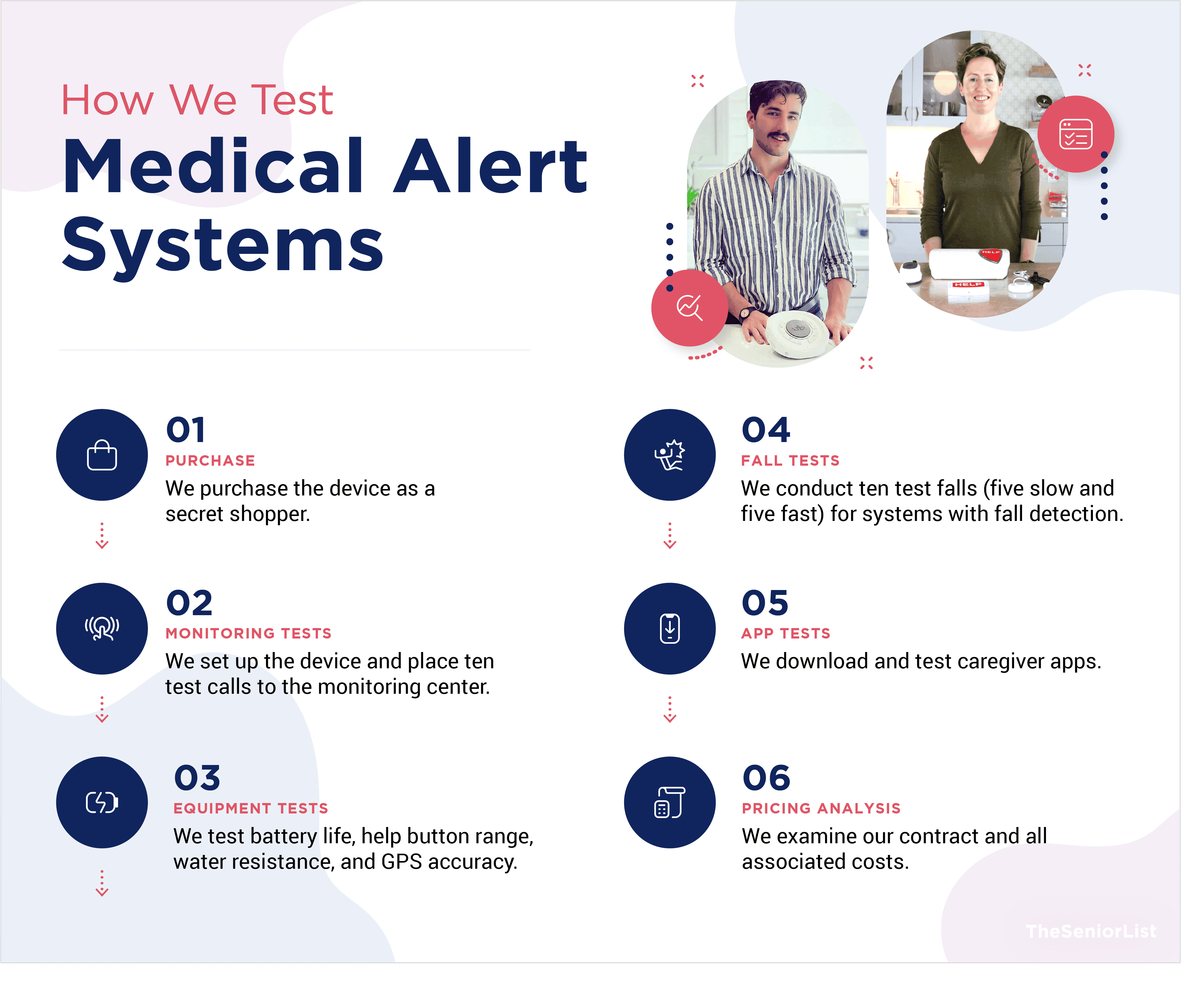
ADT currently sells three different systems. For the purposes of this test, we purchased two of them: Medical Alert Plus and On-The-Go. We evaluated each system on the following criteria:
- Response times: We placed 10 test calls with each ADT system and calculated the average response time.
- Ease of use: Through testing and design analysis, we ensured that each device was easy to use, particularly for those with visual impairments and manual dexterity issues.
- Customer care: We conducted extensive interactions with ADT’s customer care teams and monitoring agents to ensure that they offered adequate support.
- Affordable pricing: We examined the costs of our ADT systems and compared them to similar systems from other companies.
- Flexible contracts: We read the fine print of our ADT service agreement to ensure there were no unexpected fees or obligations.
- Extra features: In addition to conducting test calls, we also tested ADT’s fall detection, water-resistance, in-home range, GPS, and caregiver connectivity features
Pros and Cons of ADT Medical Alert Systems
What I Liked
- Straightforward monthly pricing: ADT only has three systems to choose from, with monthly prices ranging from $31.99 to $41.99 a month. Additionally, with ADT’s price-lock guarantee, your monthly monitoring price won’t rise.
- Optional fall detection: With the Plus and On-The-Go systems, you can add fall detection for $10 per month. In my tests, this feature worked very well, accurately sensing falls and triggering an emergency response.
- Durable equipment: Naturally, my tests require falls, drops, and even trips into the shower. Luckily, ADT’s help buttons withstood this common damage and performed their functions with aplomb. ADT’s medical alert bracelets are among the best.
- Quick response times: Between my in-home and mobile systems, response agents at ADT’s monitoring center fielded my calls in an average of 14 seconds – a faster-than-average response time.
- Temperature monitoring: ADT’s in-home systems feature temperature monitoring and will automatically contact emergency personnel in the event of dangerously low or high temperatures.
What I Didn’t Like
- Short in-home range: As the Basic and Plus systems only have ranges of 300 and 600 feet, respectively, they may not cover a larger home and yard.
- No caregiver features: Many of the best medical alert systems feature companion smartphone apps that allow loved ones to keep track of location and any system activity. Unfortunately, ADT has yet to implement an app of this nature.
FYI: The help buttons on ADT’s systems are waterproof, meaning they can protect you in the shower or even by the pool.
ADT Medical Alert Video Review
In this video, our Managing Editor, Ryan Molloy, tests out ADT’s On-the-Go system.
Packages Available
When it comes to choosing a package, ADT makes it pretty simple. They offer three systems, each of which has a different monthly cost:
- On-The-Go: This system can be used anywhere, as it comes with a wearable wrist button in addition to a cellular medical alert. Relying on AT&T’s cellular network, the cellular medical device has GPS, so the monitoring center can easily tell where I was. Plus, I added on fall detection to make sure I’m always protected, even in the event of a fall.
- Medical Alert Plus: This system is designed for use in the home. Its help buttons, worn as either a pendant or wristband, have a range of 600 feet, and they connect to help via a cellular connection. You can also add fall detection to this system.
- Medical Alert Basic: Finally, the Basic option is ideal for a user who mostly stays inside their home, as the range from the base station is only 300 feet. This is a good option for seniors with a landline in their home, and it comes with the same home temperature monitoring as the Plus system. Unlike the Plus system, Medical Alert Basic doesn’t have the option of adding fall detection.

Unboxing ADT’s Medical Alert Plus
Upon receiving my ADT Medical Alert Plus in the mail, I opened the box and found the following:
- 1 Base station
- 1 Pendant help button
- 1 Wristband help button
- 1 Fall detection pendant
- 1 System user guide
- 1 Installation guide
- 1 Fall detection user guide
Setting up my system was a pretty easy job. First, I had to select a central location for my base station. After deciding to place it in my kitchen, I simply plugged in the base, turned it on, then called ADT to activate it. In no time, my system was up and running.
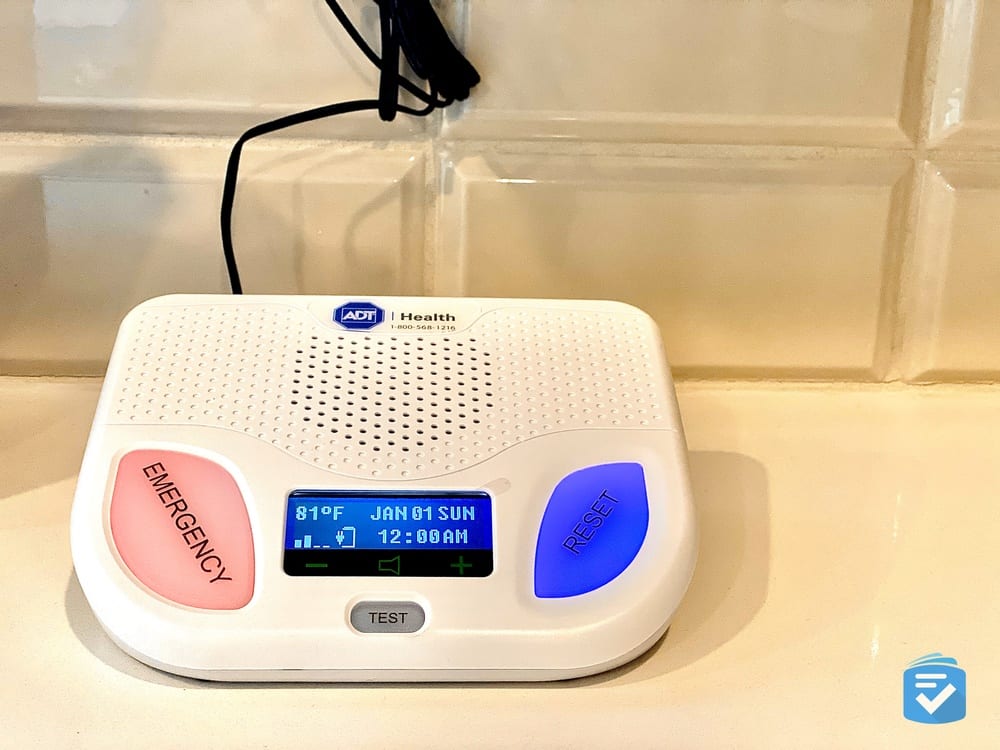
Testing ADT’s Medical Alert Plus
With my Medical Alert Plus system, I could place emergency calls in three ways by pressing my help button, triggering the fall detection pendant, or pressing the emergency button on my base station.
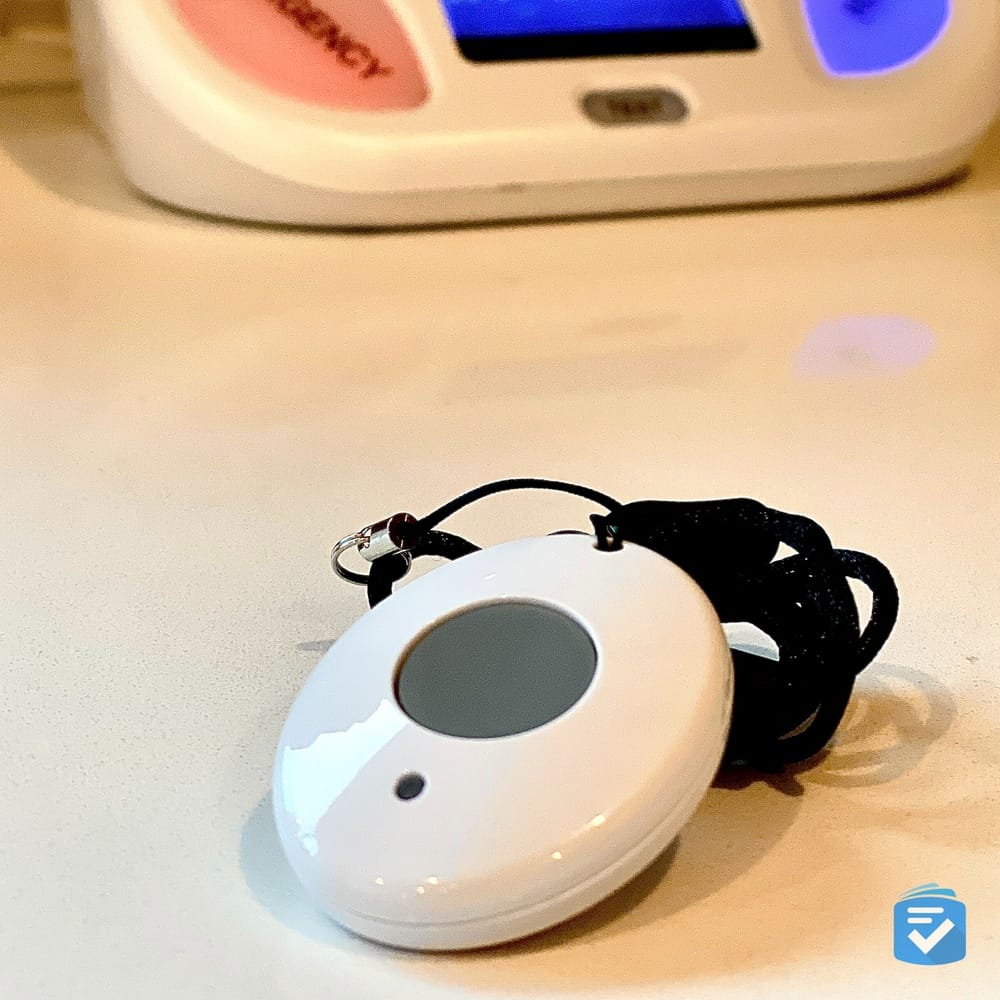
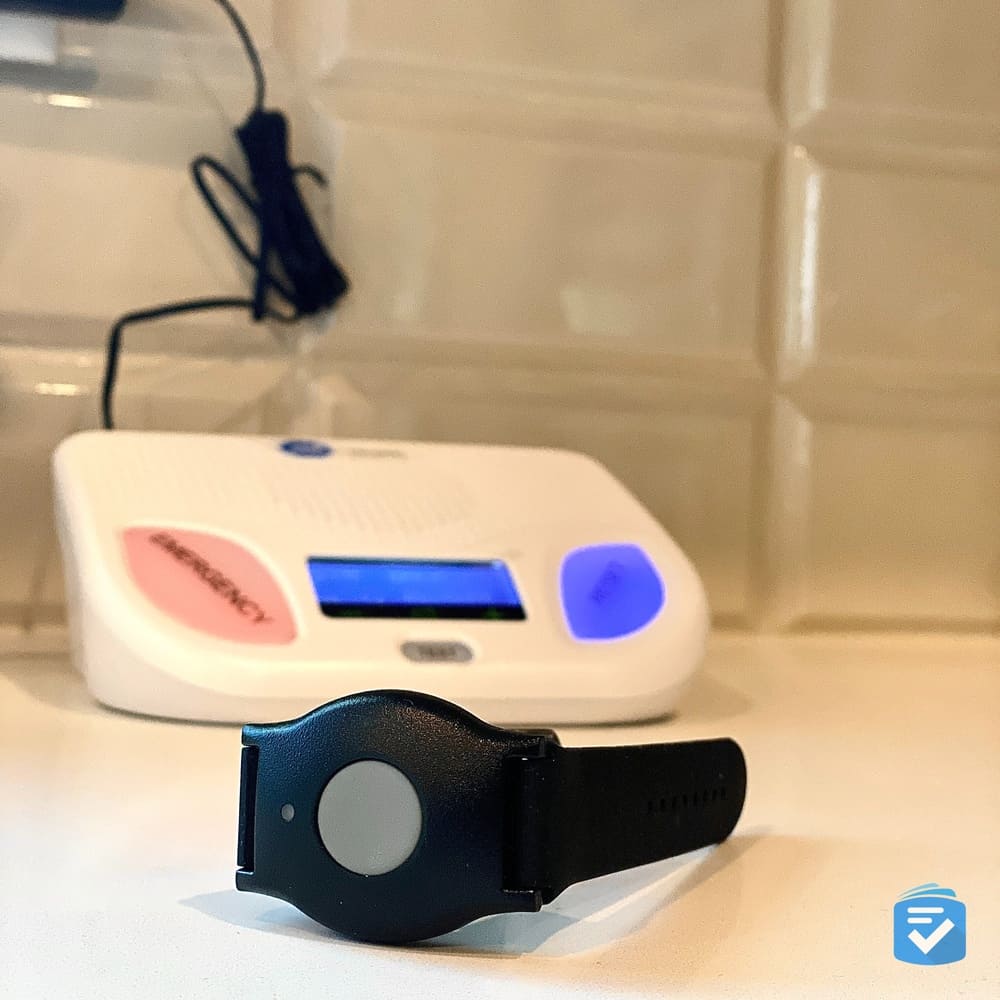
When I placed distress calls, I was quickly connected to ADT’s emergency response center. It’s important to note, however, that the base station serves as your speakerphone, meaning if you need to place a call from a different floor of your home, then you likely won’t be able to communicate through the base station. Regardless, if you place a call and the operator cannot communicate with you, they will dispatch help to your address, nevertheless.
Luckily, I found that with my base station placed in a central location, I was able to use my help button and use the loud speakerphone from every room in my house, even from out on my patio. I especially appreciated that my waterproof help buttons could be worn in the shower without fear of damaging them.
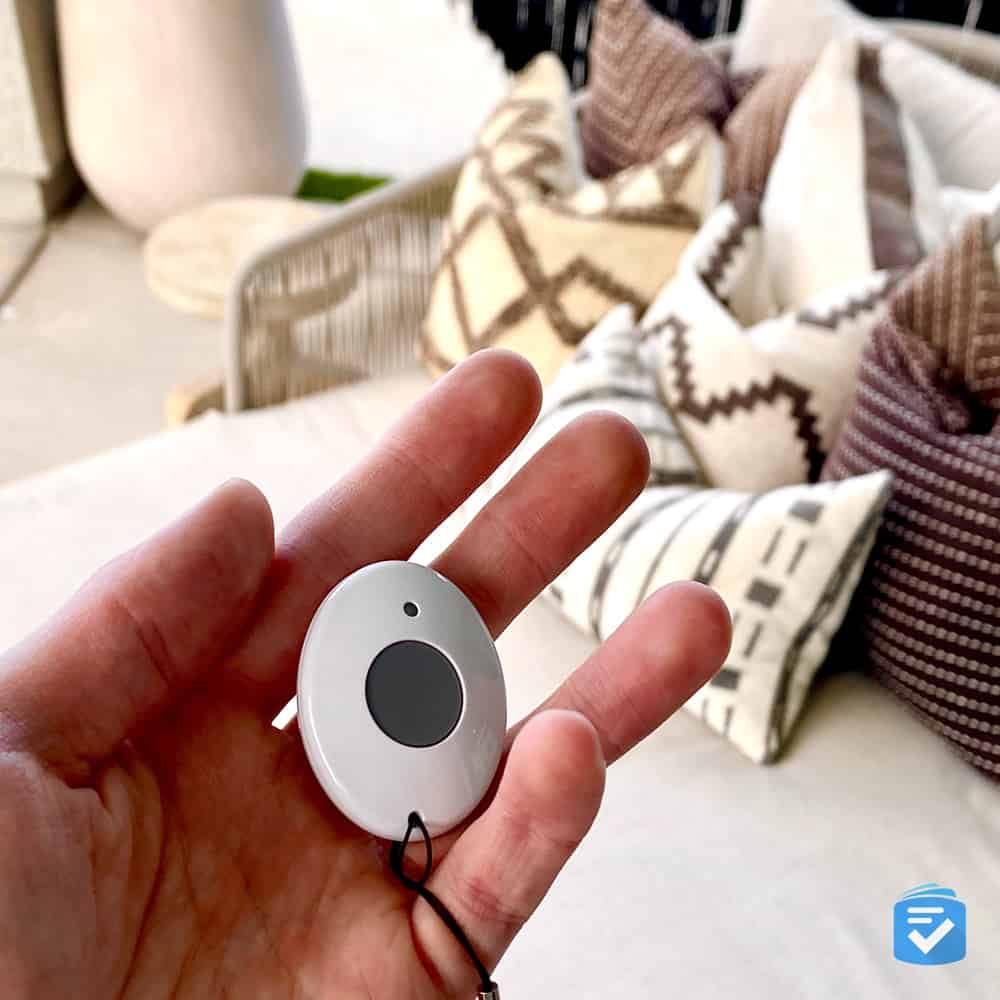
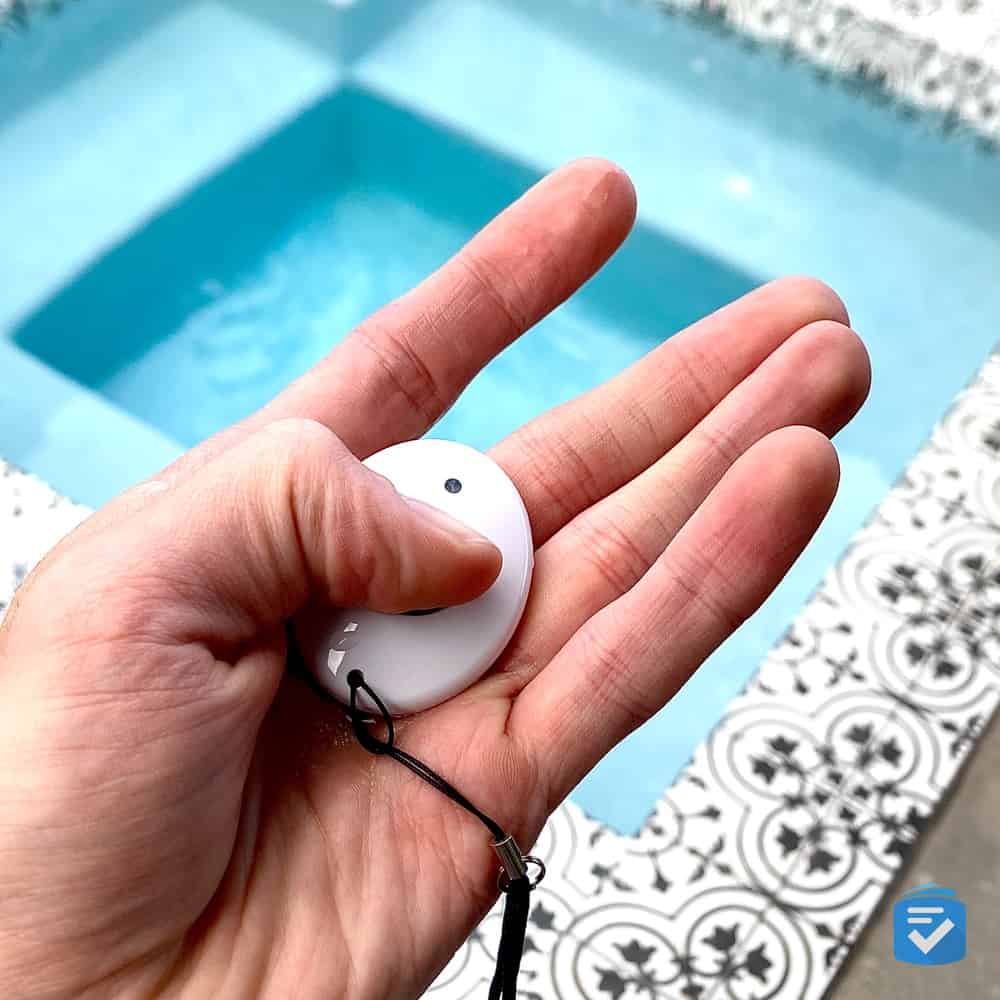
The fall detection pendant also worked well in my tests. While wearing this device, it accurately detected when I fell and triggered an emergency call. An aspect of this pendant that I really appreciated was how a fall doesn’t immediately trigger a call. For example, in one instance, I sat down quickly in a chair, which the pendant misinterpreted as a fall. Luckily, before my system called the monitoring center, my base station said, “Fall detected; press and hold button to cancel.”
Since no fall detection system is 100 percent accurate, regardless of the brand, I appreciated that ADT included this mechanism to prevent false alarms.
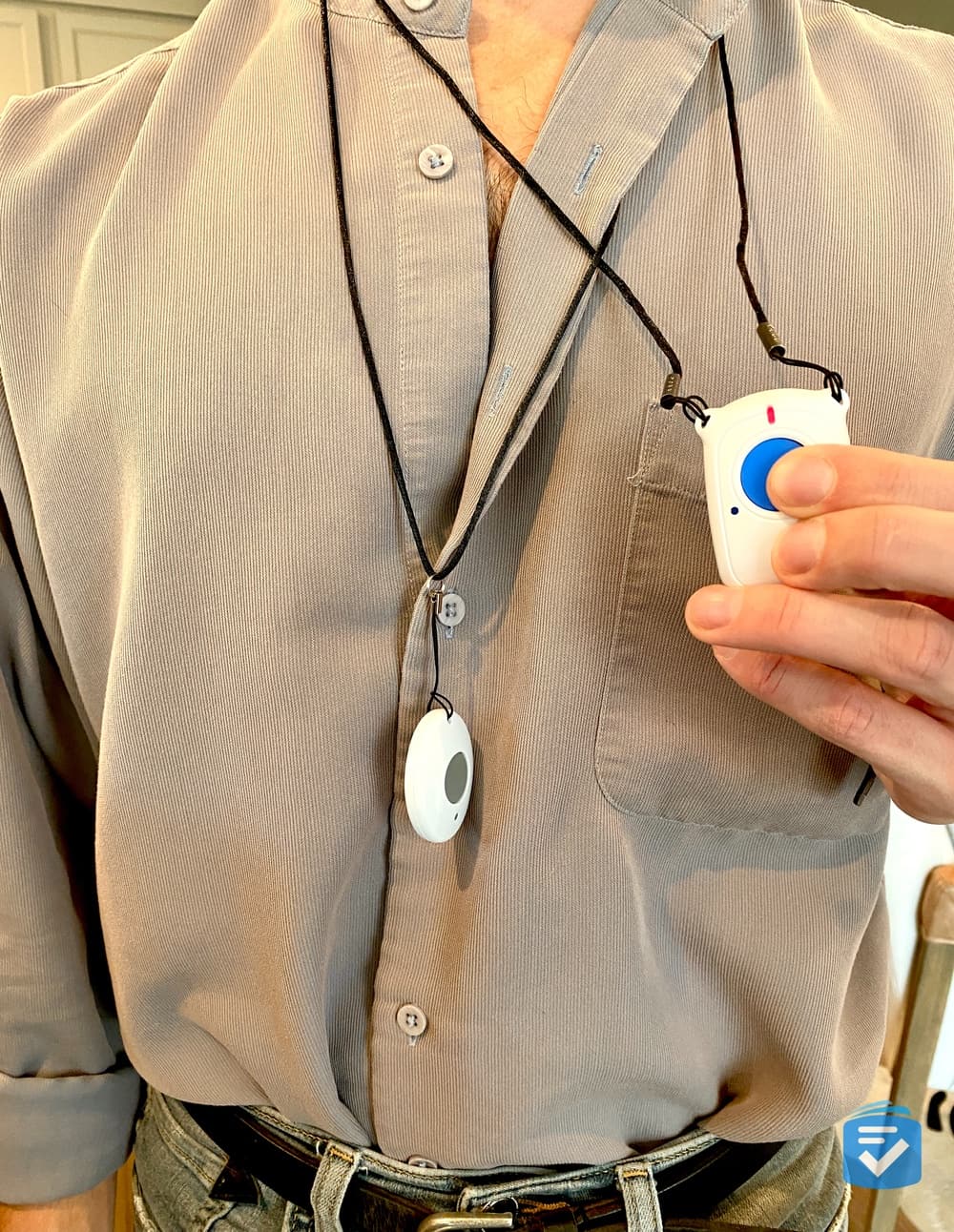
FYI: If you’re not too keen on the silicon wristband that comes with your ADT help button, you can replace it with any standard-size watch band.
Overall, I was very pleased with the performance of ADT’s Medical Alert Plus. The system performed perfectly as advertised, and each of my emergency calls was promptly fielded by a compassionate professional. I would definitely feel comfortable recommending this system to anyone looking for an in-home medical alert.
Using ADT’s On-The-Go System
For the user looking for greater protection outside the home, ADT’s On-The-Go might be just what you’re looking for. Inside my package for this system, I received the following:
- 1 Mobile device
- 1 Charging dock for mobile device
- 1 Wristband help button
- 1 Pendant help button
- 1 Fall detection pendant
- 1 Belt case for the mobile device
- 1 Lanyard for the mobile device
Setting up my On-The-Go system was even easier than the in-home system. All I had to do was plug the charging cradle into an outlet, place my mobile device on the charger, and wait a few hours for it to charge fully. Once the battery light stopped blinking, I knew my system was ready to use.
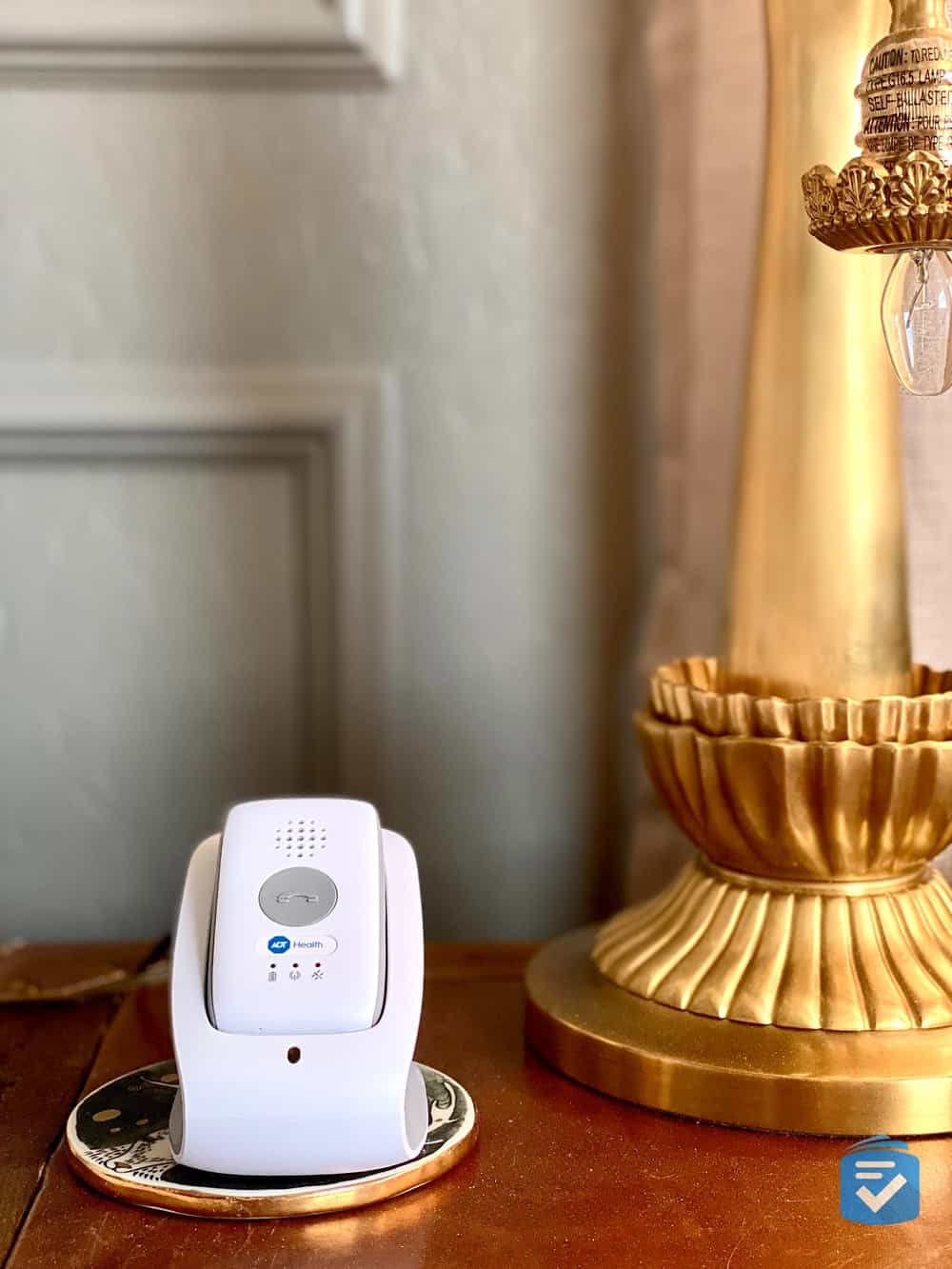
Testing ADT On-The-Go
What I appreciate most about ADT’s mobile device is that it has a speakerphone built into it. This is what allowed me to take the device anywhere, both in and outside my home. To contact ADT’s monitoring center, I simply had to press the large gray button on the device’s front, and I was quickly connected to help.
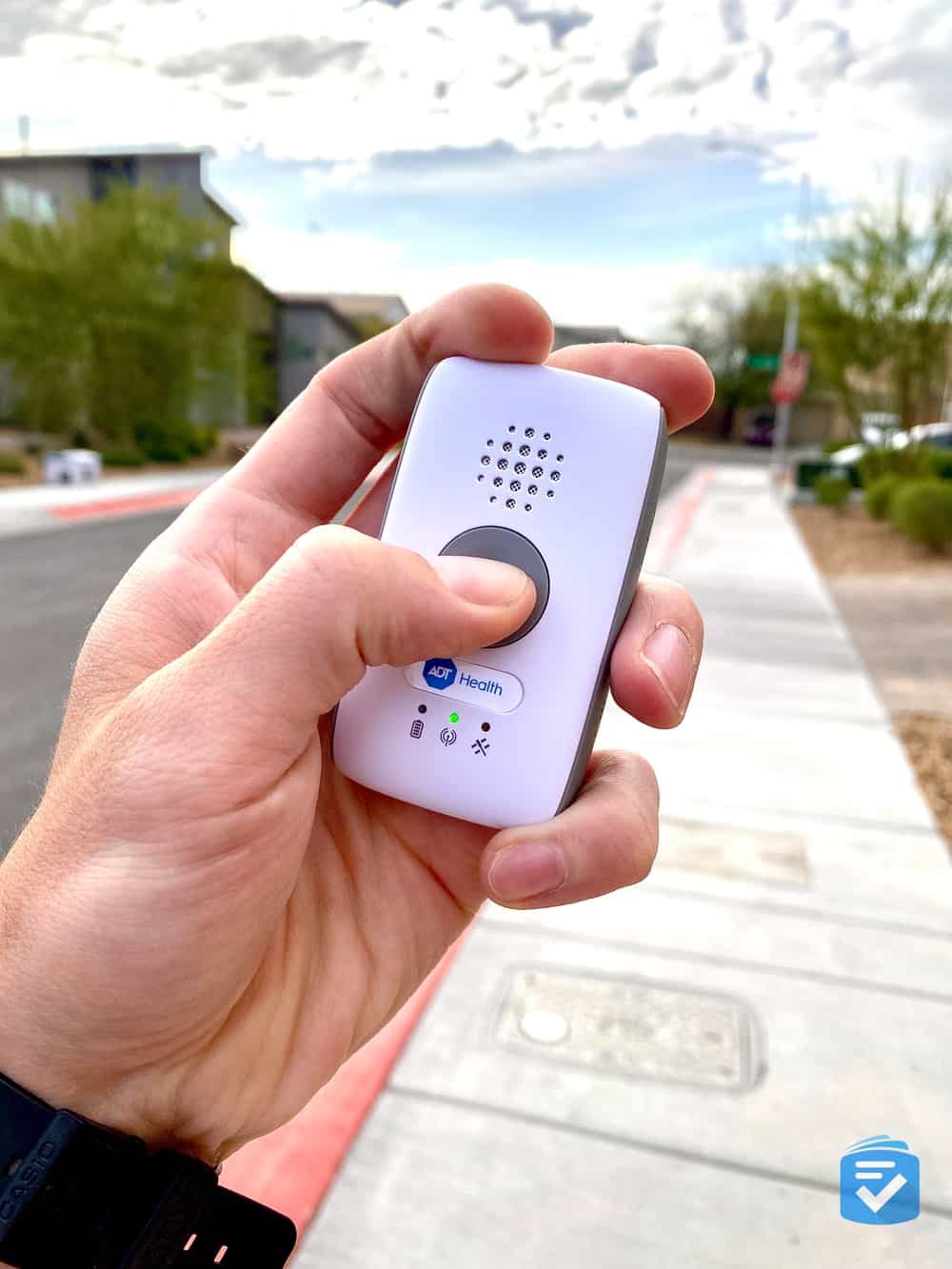
Unlike the ADT help buttons, their mobile device is not fully waterproof, meaning you should not submerge it in water. However, it is water-resistant, meaning I could take it into the shower with me. Even while wet, it still transmitted calls without a hitch. In terms of battery life, I got over a day’s worth of use on a single charge with my mobile device. With that said, I’d recommend charging it each night when you go to sleep, just to be sure.
As with the in-home system, fall detection requires an additional pendant, and this pendant worked just as well with my mobile device. The mobile device also comes with an additional help button (either a wristband or pendant). These might not seem all that necessary, considering the mobile device can call for help on its own; however, they could certainly come in handy if you’re taking a bath or charging your mobile device. In these cases, the mobile device can serve as the base station.
In terms of battery life, response time, and ease of use, I was very impressed with ADT’s On-The-Go System. No matter where I went, inside or outside, my distress calls went through. For active users, I would certainly recommend this system as a way to keep them safe on the go.
ADT Medical Alert Pricing
As opposed to companies that offer multiple plans for each product, ADT streamlines its monthly costs, offering only one plan for each system. For my On-the-Go system, I paid a total of $50.99 a month, which included the $11 fee for fall detection. For my in-home Medical Alert Plus, I paid $52.99 per month, including $11 per month for fall detection.
At a minimum, you’ll pay $31.99 a month for the Basic package. But keep in mind that you won’t pay anything upfront for ADT; rather, the monthly costs cover the rental of the equipment. As far as comparing ADT’s cost to competitors, they come in right in the middle of the road.
Sure, I’ve tested out more affordable medical alert systems, but only by a few dollars a month, and some have separate upfront costs, unlike ADT. Plus, about $50 a month for total peace of mind seems like a pretty good deal to me. And great news for your wallet, ADT locks in their prices forever, so you’ll never be surprised by a larger-than-usual bill.
Now, although I decided to pay monthly for ADT, they also offer quarterly and annual options. However, these prices aren’t available online, so you’ll need to call ADT directly to get a quote.
For more information on the costs of an ADT medical alert system, check out my overview of ADT medical alert costs.
ADT Medical Alert vs. Life Alert
While Life Alert is undoubtedly more widely known than the medical alerts from ADT, ADT medical alert systems perform better and at a much lower price point.
Life Alert’s basic in-home system starts at $49.95 per month, whereas ADT’s costs $29.99. Additionally, Life Alert requires a person to lock into a three-year contract, whereas ADT only requires you to commit on a monthly basis.
Additionally, in our tests, we found that ADT response agents answered our calls in an average of 14 seconds. This is pretty fast compared to the 30-second average we experience with Life Alert. Additionally, we experience several calls with Life Alert that took nearly two minutes to receive a response. This is far more than any wait time we experienced with our ADT systems.
My Final Thoughts on ADT
When all is said and done, ADT’s in-home and mobile systems delivered consistently solid performance. Has ADT reinvented the wheel with these medical alert systems? Not exactly. Are these systems the most affordable I’ve seen? Nope, as their prices are about average. But what ADT offers is dependability.
While testing these systems, each of my calls was quickly fielded by a compassionate individual on the other end of the line. The great customer service combined with reliable device performance makes ADT one of my favorite medical alert systems.

I’d recommend ADT if you’re looking for…
- Locked-in rates: Your rate will never go up once you sign up with ADT, which is a huge relief.
- On-the-go protection: Their all-in-one mobile device is an impressive piece of technology that, dare I say, could even protect you well inside the home.
- Waterproof devices: Since all of ADT’s devices were at minimum water-resistant, I didn’t have to worry about damaging them in the shower. Especially since showers are a common site of falls, I always look for this trait in medical alert systems.
- Short-term contracts: Systems like Life Alert cost over $50 per month and require three-year contracts; however, ADT allows you to subscribe on a monthly basis and cancel at any time.
But I wouldn’t recommend it if you wanted…
- Best fall detection: Medical Guardian’s MGMini Lite detected more falls in our full fall detection comparison.
- Longer range: Especially for the in-home systems, the ranges of 300 and 600 feet could be a drawback to people with larger homes. I will say, however, those 600 feet were enough for the first floor of my home.
- Caregiver features: If you’re looking for a caregiver portal that can track system usage, movement, or even a user’s heart rate, then you might want to consider something from QMedic or Aloe Care Health.
ADT Medical Alert System Frequently Asked Questions
-
How much will I pay monthly for ADT’s medical alert systems?
On a monthly basis, you’ll pay anywhere from $29.95 to $49.99 a month for ADT’s medical alert systems, which includes the optional fall detection monthly fee of $10.
-
What are ADT’s medical alert system options?
ADT offers three different medical alert systems: Medical Alert Basic, ideal for the home, Medical Alert Plus, which covers the home and yard, and On-The-Go, which can be used anywhere.
-
What is the warranty on my ADT medical alert system?
ADT medical alert systems come with an unconditional lifetime warranty on parts, labor and service. The user will never be charged for repairs to the unit unless the base unit or the accessories are lost or damaged.
-
Are ADT’s medical alert system devices waterproof?
Yes, all of ADT’s help buttons are waterproof, capable of being worn in the shower or bath. The one exception would be their mobile device which – while capable of getting wet – should not be fully submerged in water.
-
Can I program an ADT medical alert to contact a family member?
By default, ADT medical alerts will route your calls to the nearest monitoring center. Upon setup, you’ll provide the monitoring center with a list of contacts who a response agent can call instead of emergency responders.
-
Are ADT medical alert systems waterproof?
Yes, all of ADT’s help buttons are waterproof, capable of being worn in the shower or bath. The one exception would be their mobile device which –while capable of getting wet – should not be fully submerged in water.


